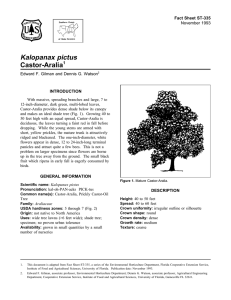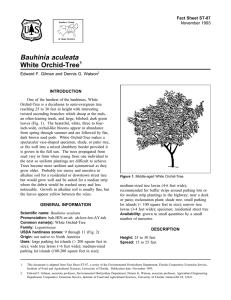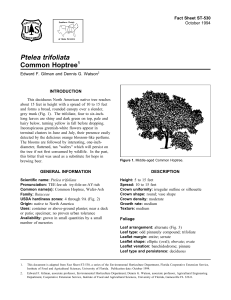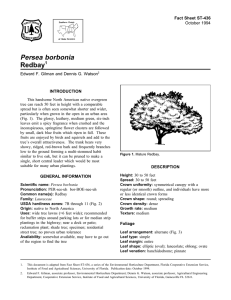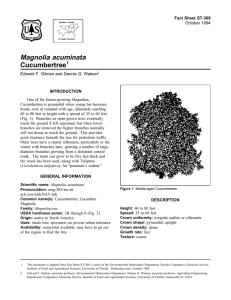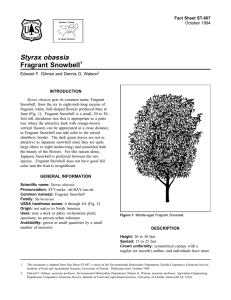Pterostyrax hispida Fragrant Epaulette Tree Fact Sheet ST-534 1
advertisement
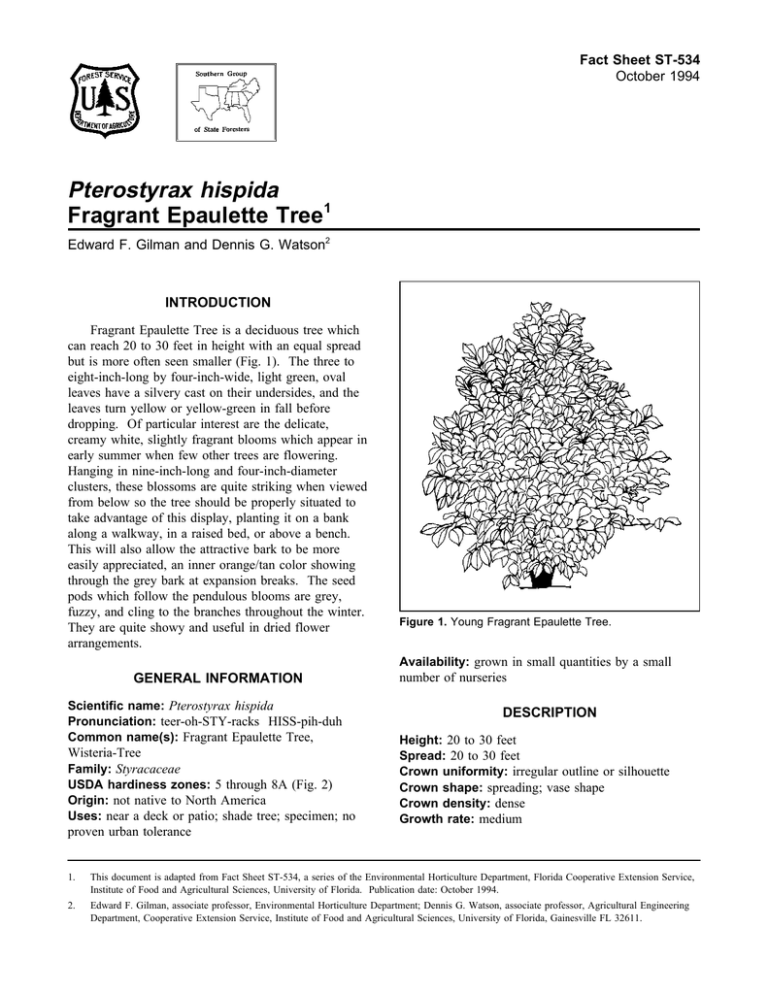
Fact Sheet ST-534 October 1994 Pterostyrax hispida Fragrant Epaulette Tree1 Edward F. Gilman and Dennis G. Watson2 INTRODUCTION Fragrant Epaulette Tree is a deciduous tree which can reach 20 to 30 feet in height with an equal spread but is more often seen smaller (Fig. 1). The three to eight-inch-long by four-inch-wide, light green, oval leaves have a silvery cast on their undersides, and the leaves turn yellow or yellow-green in fall before dropping. Of particular interest are the delicate, creamy white, slightly fragrant blooms which appear in early summer when few other trees are flowering. Hanging in nine-inch-long and four-inch-diameter clusters, these blossoms are quite striking when viewed from below so the tree should be properly situated to take advantage of this display, planting it on a bank along a walkway, in a raised bed, or above a bench. This will also allow the attractive bark to be more easily appreciated, an inner orange/tan color showing through the grey bark at expansion breaks. The seed pods which follow the pendulous blooms are grey, fuzzy, and cling to the branches throughout the winter. They are quite showy and useful in dried flower arrangements. Figure 1. Young Fragrant Epaulette Tree. Availability: grown in small quantities by a small GENERAL INFORMATION Scientific name: Pterostyrax hispida Pronunciation: teer-oh-STY-racks HISS-pih-duh Common name(s): Fragrant Epaulette Tree, Wisteria-Tree Family: Styracaceae USDA hardiness zones: 5 through 8A (Fig. 2) Origin: not native to North America Uses: near a deck or patio; shade tree; specimen; no proven urban tolerance number of nurseries DESCRIPTION Height: 20 to 30 feet Spread: 20 to 30 feet Crown uniformity: irregular outline or silhouette Crown shape: spreading; vase shape Crown density: dense Growth rate: medium 1. This document is adapted from Fact Sheet ST-534, a series of the Environmental Horticulture Department, Florida Cooperative Extension Service, Institute of Food and Agricultural Sciences, University of Florida. Publication date: October 1994. 2. Edward F. Gilman, associate professor, Environmental Horticulture Department; Dennis G. Watson, associate professor, Agricultural Engineering Department, Cooperative Extension Service, Institute of Food and Agricultural Sciences, University of Florida, Gainesville FL 32611. Pterostyrax hispida -- Fragrant Epaulette Tree Page 2 Figure 2. Shaded area represents potential planting range. Texture: coarse Fruit Foliage Fruit Fruit Fruit Fruit Fruit Leaf arrangement: alternate Leaf type: simple Leaf margin: pectinate; serrate Leaf shape: oblong; ovate Leaf venation: banchidodrome; pinnate Leaf type and persistence: deciduous Leaf blade length: 4 to 8 inches Leaf color: green Fall color: yellow Fall characteristic: not showy Flower Flower color: white Flower characteristics: pleasant fragrance; showy; summer flowering shape: oval length: < .5 inch covering: dry or hard color: brown characteristics: does not attract wildlife; no significant litter problem; persistent on the tree; showy Trunk and Branches Trunk/bark/branches: droop as the tree grows, and will require pruning for vehicular or pedestrian clearance beneath the canopy; routinely grown with, or trainable to be grown with, multiple trunks; showy trunk; tree wants to grow with several trunks but can be trained to grow with a single trunk; no thorns Pruning requirement: requires pruning to develop strong structure Breakage: resistant Current year twig color: gray Current year twig thickness: medium; thin Pterostyrax hispida -- Fragrant Epaulette Tree Culture Light requirement: tree grows in full sun Soil tolerances: clay; loam; sand; slightly alkaline; acidic; well-drained Drought tolerance: moderate Other Roots: surface roots are usually not a problem Winter interest: tree has winter interest due to unusual form, nice persistent fruits, showy winter trunk, or winter flowers Outstanding tree: tree has outstanding ornamental features and could be planted more Invasive potential: little, if any, potential at this time Pest resistance: no pests are normally seen on the tree USE AND MANAGEMENT The wide-spreading, upright-spreading branches help to make this a fabulous small shade tree, casting deep shade beneath the tree. Some early pruning may be necessary to remove the lower branches (to allow easier access below the tree) or to control the tree’s shape. Seek out this little-known tree for a specimen or group planting which is not likely to be duplicated in the near future due to the rarity of the tree. Fragrant Epaulette Tree should be grown in full sun on moist, well-drained soil. It will tolerate both acid and alkaline soils. The trees perform best when they receive no shade, becoming thin and flowering poorly in the shade. Propagation is by seed. Pests and Diseases No pests or diseases are of major concern. Page 3
